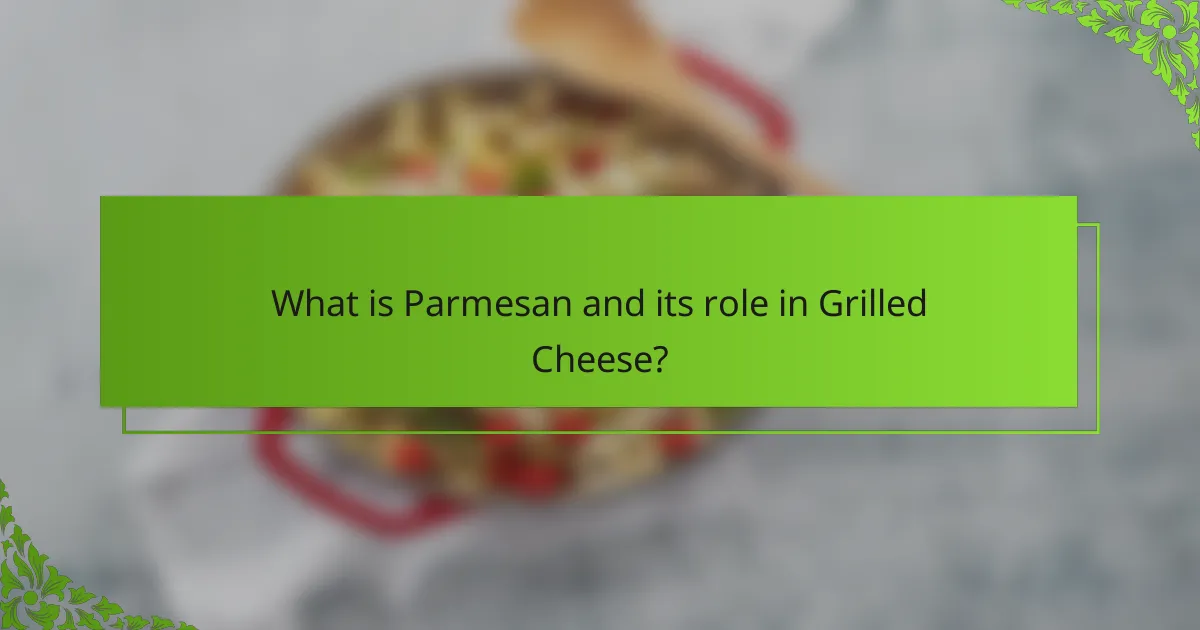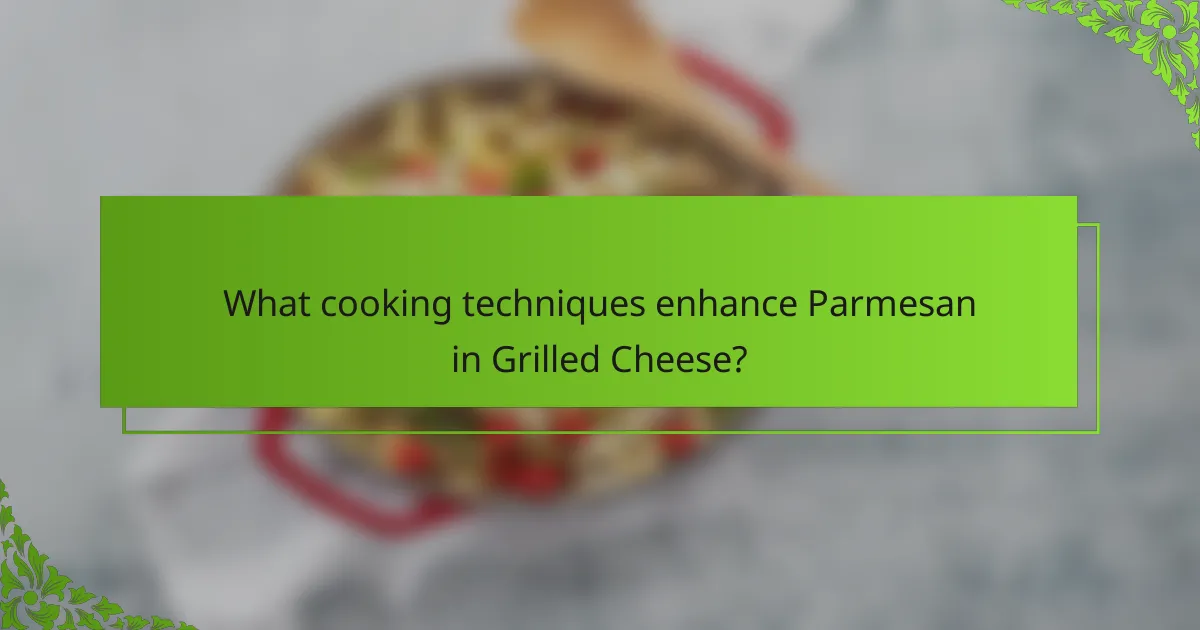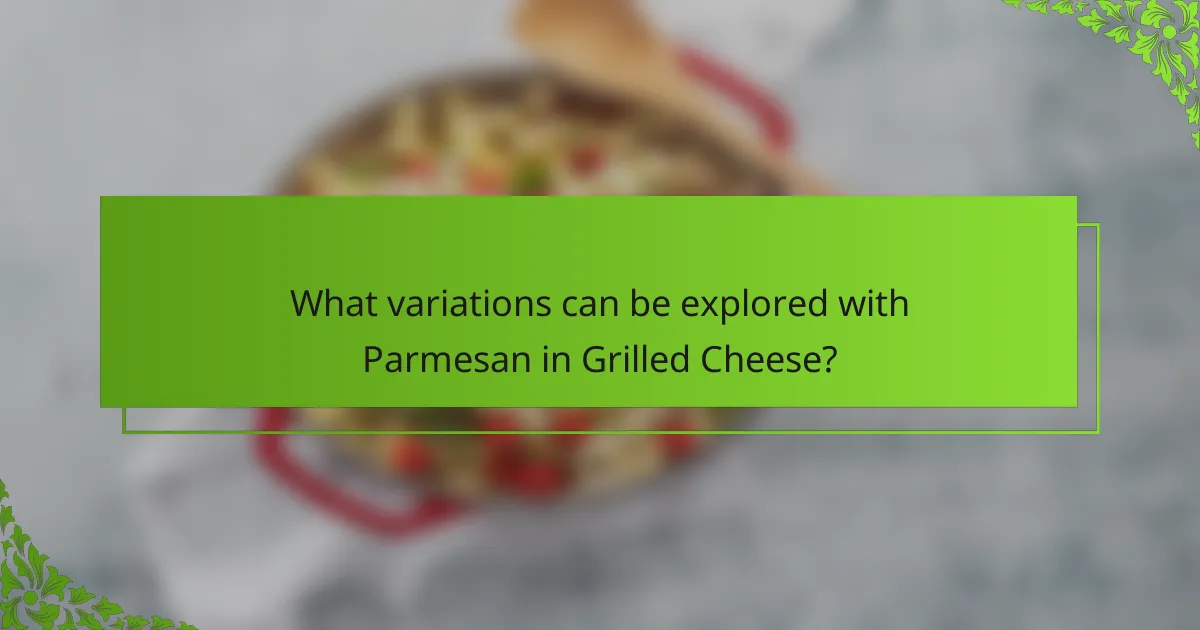Parmesan is a hard, aged cheese from Italy, made from cow’s milk and characterized by its granular texture and rich, nutty flavor. This article explores how Parmesan enhances grilled cheese sandwiches, providing a creamy texture and savory crust while complementing other ingredients. It outlines effective cooking techniques, such as low and slow cooking and using a lid, to optimize the melting process. Additionally, it discusses various ingredient combinations, including herbs, different cheeses, and vegetables, that can elevate the flavor profile of grilled cheese. Each method and variation highlights the unique qualities of Parmesan, creating diverse culinary experiences.

What is Parmesan and its role in Grilled Cheese?
Parmesan is a hard, aged cheese originating from Italy. It is made from cow’s milk and has a granular texture. Parmesan is known for its rich, nutty flavor profile. In grilled cheese, it enhances taste and adds depth. The cheese melts well, contributing to a creamy texture. Its umami notes complement other cheeses used in the sandwich. Parmesan also provides a savory crust when grilled. This cheese elevates the overall flavor experience of grilled cheese sandwiches.
How is Parmesan cheese made?
Parmesan cheese is made through a specific process involving several key steps. First, cow’s milk is heated and combined with rennet to curdle it. The curds are then cut into small pieces, which helps them release whey. After that, the curds are cooked at a controlled temperature to further expel moisture. The cooked curds are pressed into molds to shape them into wheels. Next, the cheese is salted, which enhances flavor and acts as a preservative. Finally, Parmesan is aged for a minimum of 12 months, allowing its flavor to develop. Authentic Parmesan, known as Parmigiano-Reggiano, must follow strict regulations in production, including specific geographic areas in Italy.
What are the key ingredients in Parmesan cheese?
Parmesan cheese primarily consists of cow’s milk, salt, rennet, and cultures. Cow’s milk is the main ingredient, providing the base for the cheese. Salt is added for flavor and preservation. Rennet is an enzyme that helps in curdling the milk during cheese production. Cultures are used to ferment the milk, contributing to the cheese’s flavor and texture. These ingredients are essential for creating the distinct taste and characteristics of Parmesan cheese.
How does the aging process influence Parmesan’s flavor?
The aging process significantly influences Parmesan’s flavor. As Parmesan ages, enzymes and bacteria break down proteins and fats. This process develops complex flavors, including nutty, fruity, and savory notes. The duration of aging directly correlates with flavor intensity. Younger Parmesan has a milder taste, while aged Parmesan offers a sharper, more robust flavor profile. Typically, Parmesan ages for a minimum of 12 months, with some varieties aging for up to 36 months or longer. This extended aging enhances the umami characteristics, making the cheese more flavorful. The intricate balance of flavors results from the aging environment and specific production techniques.
What are the distinct flavor profiles of Parmesan?
Parmesan has distinct flavor profiles characterized by nuttiness, saltiness, and umami. The nuttiness comes from the aging process, which enhances its complexity. Saltiness is a key aspect that balances its rich flavors. Umami contributes depth, making Parmesan savory and satisfying. Additionally, aged Parmesan may present hints of fruitiness and sweetness. The flavor intensity increases with aging, leading to a more robust profile. Parmesan’s unique taste is a result of its specific milk source and production methods. These factors collectively define the cheese’s distinctive character.
How does the aging duration affect the taste of Parmesan?
Aging duration significantly affects the taste of Parmesan. As Parmesan ages, its flavor intensifies and becomes more complex. Young Parmesan, aged for about 10 months, has a mild and creamy taste. In contrast, aged Parmesan, typically over 24 months, develops a nutty, savory flavor profile. The aging process also reduces moisture content, leading to a firmer texture. This texture change enhances the cheese’s ability to crumble and melt. Flavor compounds such as amino acids and fatty acids increase with aging, contributing to a richer taste. Studies show that aged cheeses have higher concentrations of flavor compounds, making them more desirable for culinary uses.
What are the flavor notes commonly found in Parmesan cheese?
Parmesan cheese commonly features nutty, salty, and savory flavor notes. These notes arise from the aging process, which typically lasts between 12 to 36 months. During aging, enzymes break down proteins, enhancing umami flavors. The cheese also exhibits a slight sweetness and a rich, creamy texture. Additionally, some varieties may present hints of fruitiness and a complex aroma. These distinctive flavors make Parmesan a popular choice for various culinary applications.
Why choose Parmesan for Grilled Cheese sandwiches?
Parmesan is an excellent choice for grilled cheese sandwiches due to its rich flavor and excellent melting properties. This cheese has a nutty and savory taste, enhancing the overall flavor profile of the sandwich. Parmesan’s granular texture allows it to melt beautifully when heated, creating a creamy consistency. Additionally, its aging process results in a complex flavor that deepens over time. Parmesan typically ages for 12 to 36 months, which intensifies its taste. The cheese also has a lower moisture content compared to other cheeses, preventing sogginess in the sandwich. These attributes make Parmesan a unique and flavorful option for grilled cheese.
What unique attributes does Parmesan bring to Grilled Cheese?
Parmesan brings a distinct umami flavor and a granular texture to grilled cheese. Its aging process enhances its complexity, offering nutty and savory notes. Parmesan’s low moisture content allows for a crisp crust when grilled. The cheese melts well, creating a rich, creamy interior. Additionally, its strong flavor can balance milder cheeses in a blend. Parmesan also adds a salty kick, enhancing overall taste. The cheese’s high protein content contributes to a satisfying mouthfeel. These unique attributes make Parmesan an excellent choice for gourmet grilled cheese sandwiches.
How does Parmesan compare to other cheeses in Grilled Cheese recipes?
Parmesan cheese offers a distinct flavor and texture compared to other cheeses in grilled cheese recipes. Its nutty and savory profile enhances the overall taste of the sandwich. Parmesan has a firm texture, which creates a satisfying crunch when grilled. In contrast, cheeses like cheddar or mozzarella provide a creamier, meltier consistency.
Parmesan is aged longer than many other cheeses, typically around 12 months or more. This aging process intensifies its flavor and reduces moisture content. Cheddar, for instance, can be aged for varying periods, resulting in different flavor intensities. Mozzarella, on the other hand, is fresh and soft, offering a different mouthfeel.
When used in grilled cheese, Parmesan can be combined with other cheeses to balance flavors. Its strong taste can complement milder cheeses, creating a more complex flavor profile. Additionally, Parmesan can be used as a topping, adding a crispy layer to the sandwich.
In summary, Parmesan’s unique attributes make it a flavorful alternative in grilled cheese recipes, providing a distinct crunch and robust taste compared to other cheeses.

What cooking techniques enhance Parmesan in Grilled Cheese?
Using a low and slow cooking technique enhances Parmesan in grilled cheese. This method allows the cheese to melt evenly and develop a rich flavor. Cooking on low heat prevents burning while allowing the cheese to reach its optimal texture. Additionally, using a lid while cooking can trap steam and promote melting. Toasting the bread to a golden brown adds a contrasting texture. Incorporating a bit of butter or oil can enhance browning and flavor. Lastly, adding a sprinkle of salt can elevate the overall taste of the dish. These techniques ensure that the Parmesan flavor shines through in every bite.
How do different cooking methods impact the flavor of Parmesan?
Different cooking methods significantly impact the flavor of Parmesan. Baking can enhance its nuttiness and create a crispy texture. Grilling often intensifies the cheese’s savory notes while adding a smoky flavor. Sautéing melts Parmesan, allowing it to blend with other ingredients, enriching the overall taste. Boiling, however, may dilute its flavor, making it less pronounced. Each method alters the cheese’s chemical structure, affecting its aroma and taste profile. For example, high heat can caramelize the sugars in Parmesan, resulting in a richer flavor. Thus, the method of cooking plays a crucial role in how Parmesan tastes in various dishes.
What are the benefits of using a skillet versus an oven for Grilled Cheese?
Using a skillet for grilled cheese offers quicker cooking and better control over browning. Skillets allow for direct heat, resulting in a crispy exterior. This method also enables easy flipping, ensuring even cooking. The stovetop method typically takes about 5-10 minutes, while an oven can require longer preheating and cooking times. Additionally, using a skillet can enhance flavor through the Maillard reaction, which occurs at higher temperatures. In contrast, an oven may not achieve the same level of crispiness. Thus, for immediate gratification and texture, a skillet is often preferred over an oven for grilled cheese.
How does the temperature affect the melting of Parmesan cheese?
Temperature significantly affects the melting of Parmesan cheese. Parmesan has a low moisture content, which means it does not melt as easily as other cheeses. At around 180°F (82°C), Parmesan begins to soften. As the temperature increases, it can become pliable but will not fully melt into a creamy texture. Instead, it may become grainy or separate. This is due to the cheese’s high protein and fat content, which behaves differently under heat compared to softer cheeses. When used in cooking, controlling the temperature is crucial for achieving the desired texture in dishes like grilled cheese.
What tips can improve the Grilled Cheese experience with Parmesan?
Use freshly grated Parmesan for better melting and flavor. Freshly grated cheese incorporates air, enhancing texture. Combine Parmesan with other cheeses, like mozzarella, for a balanced taste. The creaminess of mozzarella complements Parmesan’s sharpness. Toast the bread in butter or olive oil for a golden crust. This adds flavor and crunch to the sandwich. Cook on low heat to allow the cheese to melt evenly. High heat may burn the bread before the cheese melts. Experiment with additional ingredients like tomatoes or basil for variety. These additions can elevate the overall flavor profile.
How can ingredients be paired to complement Parmesan in a sandwich?
Pair ingredients such as arugula, prosciutto, and roasted red peppers to complement Parmesan in a sandwich. Arugula adds a peppery flavor that balances Parmesan’s nuttiness. Prosciutto introduces a savory, salty element that enhances the cheese’s richness. Roasted red peppers contribute sweetness and moisture, creating a well-rounded taste profile. These combinations are commonly used in gourmet sandwiches, showcasing their ability to elevate Parmesan’s distinct flavor.
What are common mistakes to avoid when making a Grilled Cheese with Parmesan?
Common mistakes to avoid when making a Grilled Cheese with Parmesan include using insufficient heat. Cooking on low heat can result in uneven melting. Overloading the sandwich with too much cheese can lead to a greasy texture. Skipping butter or oil on the bread can cause it to stick to the pan. Not allowing the cheese to come to room temperature may hinder proper melting. Using pre-grated Parmesan can affect flavor and texture. Forgetting to flip the sandwich at the right time can result in burning one side. Lastly, not using a lid can slow down the melting process. These mistakes can impact the overall quality of the grilled cheese.

What variations can be explored with Parmesan in Grilled Cheese?
Parmesan can be combined with various ingredients in grilled cheese for unique flavors. Adding herbs like basil or thyme enhances the taste profile. Incorporating different cheeses, such as mozzarella or cheddar, creates a creamy texture. Using sourdough or whole grain bread provides a distinct crunch. Experimenting with spreads like pesto or sun-dried tomato paste adds depth. Adding vegetables like spinach or roasted peppers contributes freshness. Including proteins such as prosciutto or turkey offers heartiness. Each variation highlights Parmesan’s nutty flavor while creating diverse culinary experiences.
How can different breads influence the Grilled Cheese with Parmesan?
Different breads can significantly influence the flavor and texture of Grilled Cheese with Parmesan. The choice of bread affects the overall crunchiness and chewiness of the sandwich. For example, sourdough offers a tangy flavor that complements the nutty taste of Parmesan. Whole grain bread adds a hearty texture and additional nutrients. White bread, on the other hand, provides a soft, classic base that allows the cheese to shine.
Additionally, artisanal breads with seeds or herbs can enhance the sandwich’s complexity. The moisture content in bread can also impact how well the cheese melts. Drier breads may result in a crispier exterior, while denser breads can hold more moisture, leading to a gooey inside. Each bread type brings its unique characteristics, ultimately altering the eating experience of the Grilled Cheese with Parmesan.
What are some popular bread choices for a Parmesan Grilled Cheese?
Sourdough, whole wheat, and brioche are popular bread choices for a Parmesan grilled cheese. Sourdough offers a tangy flavor and chewy texture. Whole wheat provides a nutty taste and added fiber. Brioche adds a rich, buttery taste and soft texture. Each bread complements the savory notes of Parmesan cheese effectively.
How do toppings enhance the overall flavor profile of the sandwich?
Toppings enhance the overall flavor profile of a sandwich by adding diverse tastes and textures. Ingredients like vegetables provide crunch and freshness. Meats contribute savory and umami flavors. Condiments introduce acidity and sweetness. Cheese varieties can add creaminess and saltiness. Each topping interacts with the sandwich’s base flavors. This combination creates a more complex and enjoyable eating experience. Studies show that diverse flavor profiles increase consumer satisfaction. For instance, a study published in “Food Quality and Preference” highlights how varied toppings enhance perceived taste quality.
What are some creative recipes featuring Parmesan in Grilled Cheese?
Parmesan can enhance grilled cheese with unique flavors and textures. One recipe combines Parmesan with sharp cheddar for a rich, savory taste. Another option is to mix Parmesan with garlic and herbs for an aromatic twist. Using a blend of Parmesan and mozzarella creates a gooey texture while adding flavor. A Mediterranean style can be achieved by incorporating sun-dried tomatoes and basil with Parmesan. For a spicy kick, adding Parmesan with pepper jack cheese is effective. Each of these combinations showcases Parmesan’s versatility in grilled cheese recipes.
How can herbs and spices elevate the taste of Parmesan Grilled Cheese?
Herbs and spices can significantly enhance the taste of Parmesan Grilled Cheese. They add layers of flavor that complement the nutty and salty profile of Parmesan. For instance, basil imparts a fresh, aromatic quality. Oregano brings a warm, earthy note that balances the cheese’s richness. Garlic powder adds a savory depth, enhancing the overall taste experience. Red pepper flakes introduce a spicy kick, creating a delightful contrast with the creamy texture. These additions not only elevate flavor but also contribute to a more complex palate. The right combination of herbs and spices can transform a simple grilled cheese into a gourmet dish.
What are some unique twists on traditional Grilled Cheese using Parmesan?
Parmesan can elevate traditional grilled cheese with unique twists. One option is adding caramelized onions for sweetness. Another twist includes incorporating pesto for a herby flavor. Using roasted red peppers adds a smoky taste. A blend of Parmesan with sharp cheddar offers a rich texture. Adding sliced tomatoes provides freshness. For a spicy kick, incorporate jalapeños. Using truffle oil enhances the umami profile. Each of these variations highlights Parmesan’s versatility in grilled cheese.
What practical tips can enhance your Parmesan Grilled Cheese making?
Use high-quality Parmesan for better flavor. Freshly grated Parmesan melts more evenly than pre-packaged options. Combine Parmesan with other cheeses like mozzarella for creaminess. Butter both sides of the bread for a golden crust. Cook on low heat to ensure the cheese melts without burning the bread. Use a lid on the pan to trap heat and aid melting. Experiment with adding herbs or garlic for extra flavor. Serve immediately for the best texture and taste.
Parmesan cheese is a hard, aged cheese from Italy known for its rich, nutty flavor and granular texture, making it an excellent choice for grilled cheese sandwiches. The article explores the aging process of Parmesan, which enhances its complex flavor profiles, including umami, nuttiness, and saltiness. It details the key ingredients in Parmesan, the impact of cooking techniques on its melting properties, and offers practical tips for achieving the perfect grilled cheese. Additionally, the article discusses various ingredient pairings and creative variations that elevate the culinary experience of using Parmesan in grilled cheese recipes.